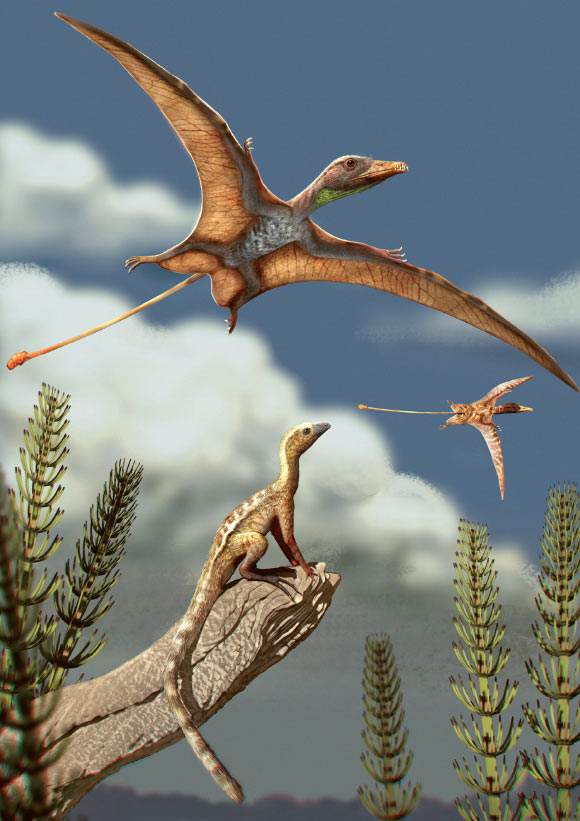In new research, an international team of researchers used high-resolution 3D imaging techniques, including microCT scanning, to reconstruct brain shapes from more than three dozen species. These included pterosaurs, their close relatives, early dinosaurs and bird precursors, modern crocodiles and birds, and a wide range of Triassic archosaurs.

Reconstruction of a Late Triassic landscape, approximately 215 million years ago; a lagerpetid, a close relative of pterosaurs, is perched on a rock, observing pterosaurs flying overhead. Image credit: Matheus Fernandes.
The oldest known pterosaurs lived approximately 220 million years ago and were already animals capable of powered flight, an ability that later evolved independently among paravian dinosaurs, the group that includes living birds and their closest non-avian relatives.
Flight is a complex locomotory mode that requires physiological adaptations and a dramatic transformation of the body plan, including changes in body proportions, specialized integument, and acquisition of new neurosensory capabilities.
Although pterosaurs and birds developed distinct skeletal and integumentary adaptations for flight, they are hypothesized to share neuroanatomical traits linked to aerial locomotion.
“Our findings add to evidence that enlarged brains seen in modern birds and presumably in their prehistoric ancestors were not the driver of pterosaurs’ ability to achieve flight,” said Dr. Matteo Fabbri, a researcher at the Johns Hopkins University School of Medicine.
“Our study shows that pterosaurs evolved flight early on in their existence and that they did so with a smaller brain similar to true non-flying dinosaurs.”
To learn whether pterosaurs acquired flight differently than birds and bats, the scientists studied the reptile’s evolutionary tree to pinpoint the evolution of pterosaur brain shape and size, looking for clues that may have led to the development of flight.
They focused particularly on the area involved in vision, the optic lobe, the growth of which is thought to be associated with flying abilities.
Using CT scans and imaging software that allowed the authors to extract information about the nervous systems of fossils, the researchers honed in on the pterosaur’s closest relative — Ixalerpeton, a species of flightless, tree-dwelling lagerpetid that lived in Brazil during the Triassic period around 233 million years ago.
“The lagerpetid’s brain already showed features linked to improved vision, including an enlarged optic lobe, an adaptation that may have later helped their pterosaur relatives take to the skies,” said Dr. Mario Bronzati, a researcher at University of Tübingen.
“A larger optic lobe was also present in pterosaurs,” Dr. Fabbri said.
However, there were otherwise very few similarities in the shape and size of pterosaur brains and that of the flying reptile’s closest relative, the lagerpetid.
“The few similarities suggest that flying pterosaurs, which appeared very soon after the lagerpetid, likely acquired flight in a burst at their origin,” Dr. Fabbri said.
“Essentially, pterosaur brains quickly transformed acquiring all they needed to take flight from the beginning.”
“By contrast, modern birds are believed to have acquired flight in a step-by-step, more gradual process, inheriting certain features, such as an enlarged cerebrum, cerebellum and optic lobes from their prehistoric relatives, and later adapting them to enable flight.”
This theory is supported by a 2024 study that pointed to the expansion of the brain’s cerebellum as a key to bird flight.
The cerebellum, located at the back of the brain, regulates and controls muscle movement among other activities.
In further studies, the researchers analyzed brain cavities of fossils from crococdylians and early, extinct birds, and compared these with pterosaur brain cavities.
They determined that the pterosaur’s brain had moderately enlarged hemispheres, similar in size to other dinosaurs, compared with the brain cavities of modern birds.
“Discoveries from southern Brazil have given us remarkable new insights into the origins of major animal groups like dinosaurs and pterosaurs,” said Dr. Rodrigo Temp Müller, a paleontologist at the Universidade Federal de Santa Maria.
“With every new fossil and study, we’re getting a clearer picture of what the early relatives of these groups were like, something that would have been almost unimaginable just a few years ago.”
“In the future, better understanding how the structure of the pterosaur brain, in addition to the size and shape, enabled flight will be the most important step to better infer the basic biological laws of flight,” Dr. Fabbri said.
The results appear in the journal Current Biology.
_____
Mario Bronzati et al. Neuroanatomical convergence between pterosaurs and non-avian paravians in the evolution of flight. Current Biology, published online November 26, 2025; doi: 10.1016/j.cub.2025.10.086







